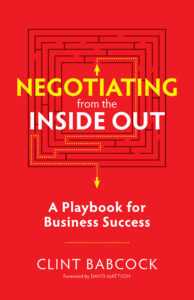Master the Skill of Negotiation
Negotiating is a skill that everyone should master. I have attended numerous classes and read all I can to learn more. The reason I am passionate about it is because understanding people is at the core of a good negotiation.
Clint Babcock talks about the inner game of negotiating in his book, Negotiating from the Inside Out. In the midst of a stressful negotiation, he shares ways to deliver the outcome that works for you. He also shares twelve classic gambits negotiators may use. I recently talked with Clint about his book.
Why is negotiating from the inside out different than other methods of negotiating?
 Obviously, there are a number of negotiation books available, and most of them are good. Some are purely academic, written from research and mock situations, while others come from former hostage and geo-political negotiators who dealt with life and death situations.
Obviously, there are a number of negotiation books available, and most of them are good. Some are purely academic, written from research and mock situations, while others come from former hostage and geo-political negotiators who dealt with life and death situations.
The focus of my book is for the business professional who has to work through various negotiation situations, especially between the buyer and the seller. Additionally, the book focuses first on how you behave as a negotiator and emphasizes that the first negotiation starts between your ears and how you feel about negotiations. The more you understand your own strengths and weaknesses, the better you’ll be in any negotiation. Lastly, we give you a structured system to work your way through a negotiation. Anything that can be systematized, can be repeated and this was our goal.
What are some of the biggest mistakes amateur negotiators make?
Amateur negotiators move straight to a concession. They fail to ask deeper questions and immediately want to please the other person by offering to adjust the price and/or deliverable. They don’t know how to truly understand what someone is asking for and do not know how to say “No” without saying “No.”
Contrast that with those of a professional or tactical negotiator.
Professional negotiators have a system. They’ve practiced how to respond as opposed to react to an “ask” by their counterpart. And they specifically know how to create more value as opposed to conceding anything that would de-value their product or service. Professional negotiators also know how to create distance between the first ask and any concession that may occur. They don’t focus on the win / win, they focus on the process of understanding what their counterpart values.
You talk about three steps of a master playbook. Is there one step that many mess up?
Yes…the first and the third! We’ll focus on the third step which is providing concessions. The mistake that happens here is usually a discount on the price or a shift to a lower solution or quality product. Usually, the best move here is to add value, meaning add product or service instead of dropping your price or solution. Add more value as a concession instead of taking something away.
How about walking us through just one of the gambits that are common?
We identified 12 of the most common gambits/moves buyers use to earn a concession, and we provide a system to deal with each one. The one gambit I hear the most from my clients is the Your Competition is Cheaper. If you receive this one on a regular basis, then consider this response:
Your Competition is Cheaper:
Step One: Acknowledge, Reassure, Ask a Question
“Thank you for sharing that with me. I can reassure you our solution is going to resolve the issues we discussed that you are having with XY&Z. I’m curious though, why do you believe my competition is offering a cheaper solution?”
If they still press on, then move to step two:
Step 2: Struggle & Redirect
“I understand you feel like it’s an apples to apples comparison, but I’m struggling a little. Let me ask you….Do you feel like our solution is missing something?
Step 3: Concessions
Ok, so it sounds like our solutions are fairly close. Let’s pretend we could include 2 more licenses or extend our services agreement an additional 6 months, would that be of value to you?
As an appendix, you include a section on negotiating remotely. That has become hugely important in a pandemic. I’d love to hear your perspective on remote negotiations in the era of COVID.
Naturally, more negotiations are remote than are face to face in the COVID era. What I believe is important is to understand that everything we discuss in the book can be done remotely. However, what we want to do is ensure we are moving all of our negotiations to the highest level of communication as possible. Buyers love to negotiate via email or text. Our goal is to move them to phone or video conference. Obviously, face-to-face is the most ideal followed by video conference. We have the ability to control the means of communication, so our goal is to control where, when, and how we negotiate.
For more information, see Negotiating from the Inside Out.
Image Credit: LinkedIn Sales Navigator.

